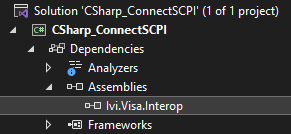
Many practical applications of VNAs require automation and remote control of the instrument. C# is well suited for this as it is a powerful and easy-to-use language with a large developer community. Using C# to control a VNA can be beneficial for users who want to customize their network analysis workflow, automate tasks, and integrate the network analyzer into their own applications or systems.
This example was created in Microsoft Visual Studio 2022 and .NET 6.0 LTS.
Before the example code will run, the library Ivi.Visa.Interop.dll must be added as a project reference. By default this library is located here:
C:\Program Files\IVI Foundation\VISA\VisaCom64\Primary Interop Assemblies
The IVI Foundation folder and containing files are installed alongside Keysight IO Libraries.
After adding the reference, it will appear in the Solution Explorer under Assemblies:

This example shows the most basic way to connect to an instrument using HiSLIP and C#. To add functionality based on your specific application, add SCPI commands using fio.WriteString(string data) and fio.ReadString() within the try...catch block. Find more SCPI commands from the SCPI Command Tree. This code uses a try...catch block to print error messages to the console instead of crashing the program.
using System;
using Ivi.Visa.Interop;
namespace CSharp_ConnectSCPI
{
internal class Program
{
static void Main(string[] args)
{
// Create the Visa Interop objects so we can use their API
ResourceManager rm = new ResourceManager();
FormattedIO488 fio = new FormattedIO488();
// Connect to a VISA address
string VISA_ADDRESS = "TCPIP0::localhost::hislip0::INSTR";
fio.IO = (IMessage)rm.Open(VISA_ADDRESS);
// Send identification request to instrument
fio.WriteString("*IDN?");
// Try to read the instrument's response
try
{
string response = fio.ReadString();
Console.WriteLine(response);
PrintErrors(fio);
}
catch (Exception ex)
{
// If error, write to console instead of crashing program
Console.WriteLine(ex.Message);
}
// Close connection to instrument
fio.IO.Close();
}
private static void PrintErrors(FormattedIO488 fio)
{
// Check how many errors are in the queue
fio.WriteString("SYST:ERR:COUN?");
int errorCount = int.Parse(fio.ReadString());
if (errorCount == 0)
return; // no errors
else
{
string errorMessage;
// Print each error message to console
for (int i = 0; i < errorCount; i++)
{
fio.WriteString("SYST:ERR?");
errorMessage = fio.ReadString();
Console.WriteLine(errorMessage);
}
}
}
}
}